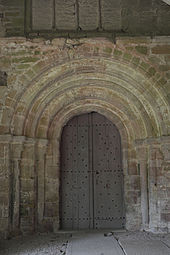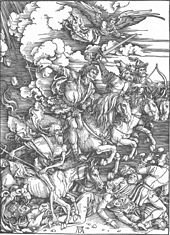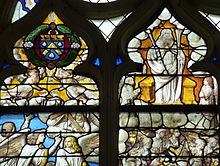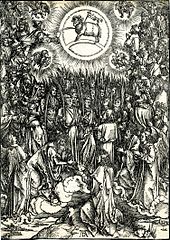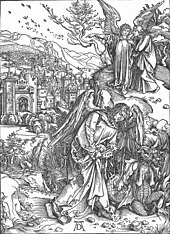St-Georges (Chavanges)
The Catholic parish church of Saint-Georges in Chavanges , a commune in the Aube department in the French region of Grand Est , dates back to the 12th century. In the 15th and 16th centuries the church was rebuilt in the Gothic style. The St. Georg , the church has numerous stained glass windows from the 16th century. In 1907, the church was added to the list of architectural monuments in France as Monument historique .
history
The nave was renovated towards the end of the 15th century in the late Gothic style. The choir was built in the early 16th century and the 37 meter high bell tower on the south side of the west facade at the end of the 16th century.
architecture
West portal
The Romanesque west portal has been preserved from the 12th century church . The arched portal is framed by simple archivolts that rest on slender pillars decorated with capitals . Stylized leaves, birds and a kneeling person are depicted on the capitals.
inner space
The nave has three naves and is divided into three bays . A two-aisled transept adjoins the nave, which opens into a wide choir. This has three apses with a polygonal end.
Renaissance window
Revelation of John (window 13)
The grisaille window with scenes from the Apocalypse was installed in 1540. The motifs are largely borrowed from the woodcuts of the Apocalypse by Albrecht Dürer , which Albrecht Dürer published in 1498 in his “Big Book” with the title The secret revelation iohannis .
Lower left scene: The commissioning of Johannes
John of Patmos receives the order from Jesus, from whose mouth a sword comes out, to write everything down.
“I, your brother John, who is besieged like you, who shares with you in the kingdom and stands steadfast with you in Jesus, I was on the island of Patmos for the word of God and the testimony for Jesus. On the Lord's day, I was seized by the Spirit and heard a voice behind me, loud as a trumpet. She said: Write what you see in a book and send it to the seven churches: to Ephesus, to Smyrna, to Pergamon, to Thyatira, to Sardis, to Philadelphia and to Laodicea. I turned around to see who was speaking to me. When I turned around I saw seven golden candlesticks and, in the middle of the candlesticks, one who looked like a human being; he was dressed in a robe that came down to his feet and he wore a belt of gold around his chest. His head and hair were white as white wool, shining white as snow, and his eyes like flames of fire; his legs shone like gold ore glowing in a furnace, and his voice was like the rush of water. In his right hand he held seven stars and from his mouth came a sharp, double-edged sword and his face shone like the powerfully shining sun. When I saw him, I fell down as if dead at his feet. But he put his right hand on me and said: Do not be afraid! I am the first and the last and the living one. I was dead, but now I live forever and I have the keys to death and the underworld. Write down what you saw: what is and what will happen afterwards. The mysterious meaning of the seven stars that you saw on my right hand and the seven golden candlesticks is: The seven stars are the angels of the seven churches and the seven candlesticks are the seven churches. ”( Rev 1 : 9-20 LU )
Second scene from the bottom left: The four horsemen of the apocalyptic
In this scene the four horsemen of the apocalyptic can be seen. The monster with its wide open mouth on the lower left edge symbolizes hell.
“Then I saw: the Lamb opened the first of the seven seals; and I heard the first of the four living beings shout like a thunderous voice: Come! Then I saw a white horse; and he who sat on it had a bow. A wreath was given to him, and when he was victorious, he set out to win. When the Lamb opened the second seal, I heard the second living being call out: Come! Another horse appeared; that was fiery red. And he who sat on it was empowered to rob the earth of peace so that people might slaughter one another. And a great sword was given to him. When the Lamb opened the third seal, I heard the third living being call out: Come! Then I saw a black horse; and he who sat on it had a scale in his hand. In the midst of the four living beings I heard something like a voice say: One measure of wheat for one denarius and three measures of barley for one denarius. But do no harm to the oil and the wine! When the Lamb opened the fourth seal, I heard the voice of the fourth living being call out: Come! Then I saw a pale horse; and he who sat on it is called "death"; and the underworld followed him. And they were given power over a quarter of the earth, power to kill by sword, hunger and death, and by the animals of the earth. ”( Rev 6 : 1-8 LU )
Third scene from the top left: fifth and sixth seals
In the upper scene, angels distribute white robes from a large chest, underneath glowing stars fall from heaven to earth, on which lamenting people desperately seek protection, including a bishop and a king.
“When the Lamb opened the fifth seal, I saw under the altar the souls of all who had been slaughtered because of the word of God and because of the testimony they had given. They shouted in a loud voice: How much longer do you hesitate, Lord, you holy and true one, to keep judgment and to avenge our blood on the inhabitants of the earth? A white robe was given to each of them; and they were told to wait a little longer until the full number was reached through the death of their fellow servants and brothers who would still die like them. And I saw: the Lamb opened the sixth seal. There was a huge tremor. The sun turned black like a mourning robe and the whole moon turned like blood. The stars of the sky fell to the earth as if a fig tree sheds its fruit when a violent storm shakes it. The sky disappeared like a scroll rolled up, and all the mountains and islands were moved away from their place. And the kings of the earth, the great and the military leaders, the rich and the mighty, all the slaves and all the free hid themselves in the caves and rocks of the mountains. They said to the mountains and rocks, Fall on us and hide us from the sight of him who sits on the throne and from the wrath of the Lamb; for the great day of their wrath has come. Who can stand there? "( Rev 6: 9-17 LU )
Scene top left: The sealed
Above are four angels, one holding the cross in his hands, another a sword. Another angel "seals" a chosen one by drawing a cross on his forehead with his finger.
“Then I saw four angels standing at the four corners of the earth, they held the four winds of the earth, so that no wind blows over the earth, nor over the sea, nor over any tree. And I saw another angel rising from the rising of the sun, who had the seal of the living God and called with a loud voice to the four angels, who had been given power to harm the earth and the sea: Do the earth and the sea and no harm to the trees until we seal the servants of our God on their foreheads ”( Rev 7 : 1-8 LU )
Second scene from top left: The sixth trumpet
In the lower area you can see angels chopping off people's heads with swords. In the foreground a Pope can be recognized by his tiara , in the upper part the army rides on fire-breathing horses.
“The sixth angel blew his trumpet: then I heard a voice coming from the four horns of the golden altar that stands before God. The voice said to the sixth angel, who is holding the trumpet: Untie the four angels who are tied to the great river, the Eufrat. Then the four angels were released, who stood ready for the year and month, day and hour to kill a third of humanity. And the number of the horsemen of this army was many thousand times a thousand; I heard that number. And this is what the horses and riders looked like in the vision: They wore fire-red, smoke-blue and sulfur-yellow armor. The horses 'heads were like lions' heads, and fire, smoke, and brimstone pounded out of their mouths. A third of the people were killed by these three plagues, fire, smoke, and brimstone that came out of their mouths. For the deadly power of horses was in their mouths and in their tails. Their tails were like snakes that have heads that they can use to cause harm. But the rest of the people who had not perished as a result of these plagues did not turn away from the work of their hands: They did not cease to prostrate themselves before their demons, before their idols made of gold, silver, ore, stone and wood, the idols who can neither see nor hear nor walk. They did not give up murder and sorcery, fornication and theft. ”( Rev 9: 13-21 LU )
Fourth scene from top left: The two animals
“And I saw that an animal came out of the sea with ten horns and seven heads. It had ten tiaras on its horns and names on its heads that were blasphemous. The animal I saw was like a panther; his feet were like the paws of a bear, and his mouth like the mouth of a lion. And the dragon had given him his power, his throne and his great power. One of its heads looked fatally wounded; but the fatal wound was healed. And the whole earth watched the animal in amazement. People prostrated before the dragon because he had given his power to the beast; and they worshiped the beast and said, Who is like the beast and who can fight it? (...) And I saw: Another animal rose from the earth. It had two horns like a lamb, but it spoke like a dragon. ”( Rev 13 : 1–11 LU )
Fourth scene from the top left (tip of the lancet): The hour of the harvest
“Then I saw a white cloud. On the cloud sat someone who looked like a son of man. He wore a golden wreath on his head and a sharp sickle in his hand. And another angel came out of the temple and called out to him who was sitting on the cloud in a loud voice: Send out your sickle and reap! Because the time to harvest has come: the fruit of the earth has ripe. And he who sat on the cloud hurled his sickle over the earth, and the earth was harvested. And another angel came out of the heavenly temple. He too had a sharp sickle. Another angel came from the altar and had power over the fire. To those who carried the sharp sickle he called out in a loud voice: Send out your sharp sickle and harvest the grapes from the vine of the earth! Its berries have ripe. Then the angel hurled his sickle on the earth, reaped the vine from the earth, and threw the grapes into the great wine press of God's wrath. The wine press was kicked outside the city and blood streamed from the wine press; it rose to the reins of the horses, one thousand six hundred stadia. "( Rev 14 : 14-20 LU )
Scene top right: The lamb and his entourage
“And I saw that the Lamb stood on Mount Zion, and with him were a hundred and forty-four thousand; on their foreheads they bore his name and his father's name. Then I heard a voice from heaven that resembled the rush of water and the rolling of a mighty thunder. The voice I heard was like the sound of the harp being played by a harpist. And they sang a new song before the throne and before the four living creatures and before the elders. But no one could learn to sing the song save the one hundred and forty-four thousand who were ransomed and taken from the earth. It is they who have not stained themselves with women; because they are virgin. They follow the lamb wherever it goes. They alone among all men are ransomed as a firstfruits gift to God and the Lamb. Because there was no lie in her mouth. They are without blemish. "( Rev 14 : 1-5 LU )
Fourth scene from the bottom left: The whore of Babylon
“Then one of the seven angels who carried the seven bowls came and said to me: Come, I will show you the judgment of the great whore who sits by the many waters. For with her the kings of the earth committed fornication and the inhabitants of the earth got drunk from the wine of her fornication. The spirit took hold of me and the angel took me into the desert. There I saw a woman seated on a scarlet animal, which was described over and over with blasphemous names, and which had seven heads and ten horns. The woman was dressed in purple and scarlet and adorned with gold, precious stones and pearls. In her hand she held a gold cup filled with the hideous filth of her fornication. On her forehead was a name, a mysterious name: Babylon, the great, mother of the whores and of all the abominations of the earth. And I saw that the woman was drunk with the blood of the saints and the blood of the witnesses of Jesus. At the sight of the woman I was amazed. ”( Rev 17 : 1-6 LU )
Scene on the far right below: The shackling of the dragon and the New Jerusalem
The scene is dominated by an angel who holds a large key in his hand and who, depicted with horns and scaled armor, puts a heavy chain around the neck of the devil and pushes it into a hole, from which flames beat. Above the scene are John and an angel pointing to the New Jerusalem .
“Then I saw an angel descending from heaven; in his hand he carried the key to the abyss and a heavy chain. He overpowered the dragon, the old serpent - that is the devil or Satan - and he bound him for a thousand years. He threw it into the abyss, closed it and pressed a seal on it so that the dragon could no longer seduce the people until the thousand years are completed. After that he must be released for a short time. "( Rev 20 : 1-3 LU )
“And one of the seven angels came who had carried the seven bowls with the seven last plagues. He said to me: Come on, I will show you the bride, the Lamb's wife. Then he raptured me up a great, high mountain and showed me the holy city of Jerusalem as it came down from God out of heaven, filled with the glory of God. It shone like a precious gem, like crystal jasper. The city has a great and high wall with twelve gates and twelve angels on them. Names are written on the gates: the names of the twelve tribes of the sons of Israel. The city has three gates in the east, three gates in the north, three gates in the south and three gates in the west. The city wall has twelve foundation stones; on them are the twelve names of the twelve apostles of the Lamb. ”( Rev 21 : 1-4 LU )
Christ on the cross (window 0)
The central choir window has tracery fragments from the 16th century. Christ on the cross can be seen on a disk.
God the Father and Angels (Window 1)
Only fragments of this window are still preserved in the tracery. On the upper plate is the Father shown, on the lower panes angel.
Passion and Resurrection of Christ (Window 2)
The two upper panes depict the Descent from the Cross and the Lamentation of Christ , the scenes below the Entombment and Resurrection of Christ , the Descent into Hell and the Risen One who appears to his mother Mary. On the two lower panes the encounter between Jesus and Mary Magdalene at the empty tomb ( Noli me tangere ) and the unbelieving Thomas are depicted.
Nativity (window 3)
From this window only the middle scene with the depiction of the birth of Christ remains.
Ascension Day (window 4)
The depiction of the ascension of Jesus shows the apostles looking up, where Jesus, of whom only his feet can be seen, disappears in a cloud.
Beheading of John the Baptist (Window 5)
From the grisaille window dedicated to John the Baptist , only the scenes with the dance of Salome and the beheading of John remain.
Vision of the Emperor Augustus (Window 9)
This grisaille window is dedicated to the vision of the emperor Augustus , to whom the Tiburtine Sibyl shows a woman with a child who is taller than him in the sky. Augustus, whom his courtiers want to worship as God, then falls on his knees and worships the child.
More windows
- Scenes from the life of the Apostle Thomas (window 7)
- Fall of Man and Expulsion from Paradise (Window 8)
- Mary Magdalene (window 10)
- The miraculous catch of fish (window 11)
- Coronation of Mary and Holy Trinity (window 15)
- Saint Nicholas and the Scholars in the Salt Barrel (window 102)
- Archangel Michael and Founder (Window 106)
Cemetery cross
In front of the entrance on the south side of the church there is a cemetery cross from the 16th century. A holy water font is carved into the base of the stone cross .
literature
- Églises accueillantes. Aube en Champagne . Ed. Pastorale du Tourisme et des Loisirs, Troyes o. J.
Web links
- Église Saint-Georges in the Base Mérimée of the French Ministry of Culture (French)
- Église paroissiale Saint-Georges Direction Régionale des Affaires Culturelles de Champagne-Ardenne (accessed October 10, 2015, in French)
Individual evidence
- ↑ Window of the Apocalypse in Base Palissy of the French Ministry of Culture (French)
- ↑ Christ on the Cross window in Base Palissy of the French Ministry of Culture (French)
- ↑ God the Father and Angels window in Base Palissy of the French Ministry of Culture (French)
- ↑ Window of the Passion and Resurrection of Christ in the Base Palissy of the French Ministry of Culture (French)
- ↑ Window of the Nativity in Base Palissy of the French Ministry of Culture (French)
- ↑ Window of the Ascension of Christ in Base Palissy of the French Ministry of Culture (French)
- ^ Window of John the Baptist in the Base Palissy of the French Ministry of Culture (French)
- ↑ Window of the vision of Emperor Augustus in the Base Palissy of the French Ministry of Culture (French)
- ↑ Window of the Apostle Thomas in the Base Palissy of the French Ministry of Culture (French)
- ^ Adam and Eve window in Base Palissy of the French Ministry of Culture (French)
- ^ Window of Maria Magdalena in the Base Palissy of the French Ministry of Culture (French)
- ↑ Window of the Wonderful Fishing in Base Palissy of the French Ministry of Culture (French)
- ^ Window of the Coronation of Mary in the Base Palissy of the French Ministry of Culture (French)
- ↑ Window of St. Nicholas in the Base Palissy of the French Ministry of Culture (French)
- ↑ Window of St. Michael in the Base Palissy of the French Ministry of Culture (French)
- ^ Cemetery cross in the Base Palissy of the French Ministry of Culture (French)
Coordinates: 48 ° 30 ′ 27.7 " N , 4 ° 34 ′ 22.3" E

